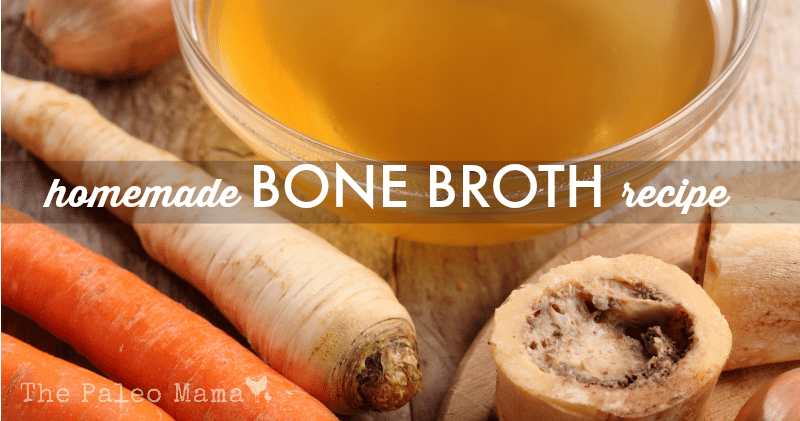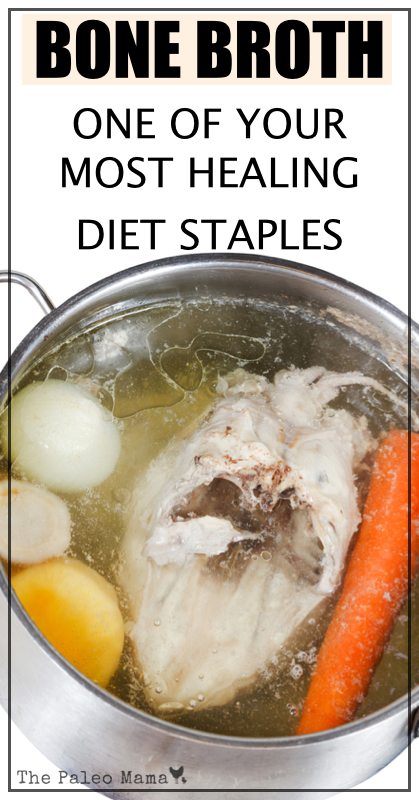
This recipe was generously shared by Sylvie McCracken, author of The Gelatin Secret. CLICK HERE to check out this amazing book filled with simple, gelatin recipes!
According to an old South American proverb, “good broth will resurrect the dead.” While that’s undoubtedly an exaggeration, it speaks to the value placed on this wholesome food, going back through the annals of time.
First and foremost, homemade bone broth is excellent for speeding healing and recuperation from illness. You’ve undoubtedly heard the old adage that chicken soup will help cure a cold, and there’s scientific support for such a statement. However, there are so many more benefits of homemade bone broth.
Homemade bone broth benefits:
- Helps heal and seal your gut, and promotes healthy digestion
- Inhibits infection
- Reduces joint pain and inflammation
- Fights inflammation
- Promotes healthy hair and nail growth
- Promotes strong and healthy bones
Sylvie McCracken, author of The Geletin Secret, stresses the importance of gelatin-rich bone broth. Using bones from pastured or wild ruminants and poultry will give you the most nutritious bone broth.
If you are new to making bone broth, then Sylvie recommends you start with chicken bones, since it is the most palatable for beginners.
What kind of bones to use:
- Chicken
- Beef
- Lamb
- Fish
Homemade Bone Broth Recipe
shared from The Gelatin Secret!
What you will need:
- Slow cooker
- 1–2 Tbsp Organic unfiltered Apple Cider Vinegar
- Filtered water Quality bones: as little or as many as you want — 2lbs is a good starting point, either frozen or thawed
Slow Cooker Directions:
1. Turn the slow cooker on “High”
2. Add your bones to the slow cooker. They can be frozen or thawed. The more bones you add, the thicker the broth will be. I typically add the carcasses of 2 roast chickens and some extra chicken heads and feet I get from my local farmer.
3. If you’d like, add some vegetable scraps like onions, carrots, and celery for flavor. I usually keep it pretty minimal so I can salt and flavor later as needed depending on what I’ll be using it for.
4. Add 1–2 Tbsp apple cider vinegar. This is optional but recommended because the vinegar helps extract the minerals from the bones, but it also makes the broth slightly less palatable so don’t go overboard.
5. Add filtered water to the slow cooker until the bones are covered, leaving about an inch of room at the top.
6. Let it cook for at least 24 hours, ideally 48 or even longer!
7. Once you’re ready to harvest your broth, pour it through a strainer into a pot or bowl and allow it to cool.
8. Use it or freeze it for later! (See How to Store Bone Broth).
9. When it cools it may have a thick layer of fat at the top. You can certainly eat it but sometimes I find it tough to digest so I skim it off and cook with it instead.
10. If you’ve used a good amount of bones, your broth will likely gel in the fridge. This is great! Don’t fret if your broth doesn’t gel after cooling.
CLICK HERE to see more gelatin-rich recipes that are simple and nutritious!

I’ve seen many people talking about bone broth in canning groups on Facebook. They sometimes roast the bones before simmering them down to broth for days and then pressure can them for shelf stable storage. How do you use the skimmed fat in cooking? I didn’t skim the fat off my turkey broth first because I thought it might make a richer dressing our turkey soup stock later but I’m interested in cutting back on store bought oils.
We love using homemade beef stock. It really makes a difference in the taste of your recipes. I see you use apple cider vinegar in your recipe. I’ve heard quite a few people do this now. We haven’t tried it yet, but think it would give a nice zing to the broth. Will add it to our recipe in the next batch. Thanks!
I highly recommend raw apple cider vinegar…it’s fantastic in many uses.